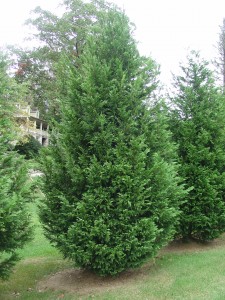If you grew up with a spruce or a fir Christmas tree, Leyland Cypress (x Cupressocyparis leylandii) could be a big change. This conifer species thrives in the southern U.S. (USDA hardiness zones 7-b to 9). Leyland is a good choice for a live cut or transplanted holiday tree as firs (Abies spp.) and spruces (Picea spp.) fail in the southern U.S. heat and humidity. It also grows well in a landscape container.
The scale-like foliage holds its natural green color much better and does not shed compared to the popular Fraser or balsam firs. If it does not, the tree is likely bone dry and a potential fire hazard.
Don’t purchase a leyland that has been cut more than two weeks and laying in a tree sale lot. It is better to visit a Choose and Cut grower. A fresh cut leyland from a tree lot generally does not need to be re-cut when setting the butt into the stand. Leyland can hold heavy ornaments if it has been properly sheared at the tree farm.
Once set up in the home, keep the cut tree away from heating vents and water as needed. Similarly, a live balled and burlapped (b&b) or container tree should be treated the same. Inside a warm home too long, it may break dormancy and be susceptible to the frigid winter weather when transplanted outdoors. Limit its time inside the home to two weeks.
Leyland continues to increase in popularity as a Southern Christmas tree. It is ready to sell as a Christmas tree in 4 to 5 years compare to 7 to 8 years for firs, pines and spruces.
Credit: Dr. Ken Tilt, retired professor of Horticulture from Auburn University, provided much of the information written here.


 Posted in
Posted in 
